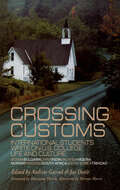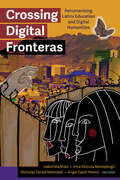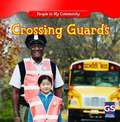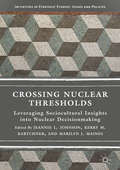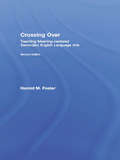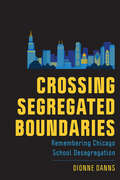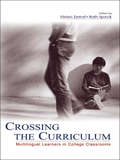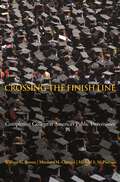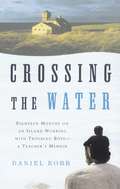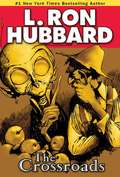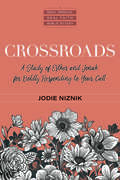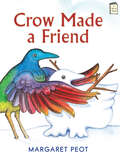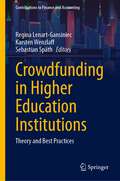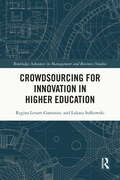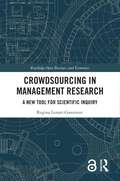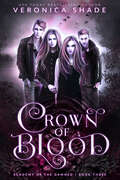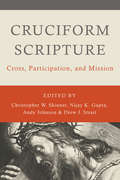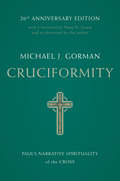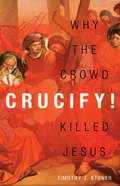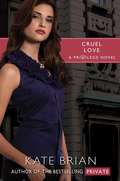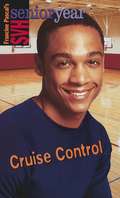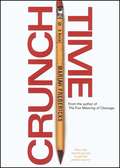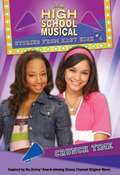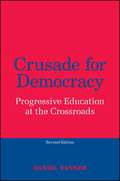- Table View
- List View
Crossing Customs: International Students Write on U.S. College Life and Culture (RoutledgeFalmer Studies in Higher Education #Vol. 18)
by Andrew Garrod Jay DavisFirst Published in 1999. Routledge is an imprint of Taylor & Francis, an informa company.
Crossing Digital Fronteras: Rehumanizing Latinx Education and Digital Humanities
by Isabel Martinez Irma Victoria Montelongo Nicholas Daniel Natividad Ángel David NievesCrossing Digital Fronteras is about liberatory possibilities and digital technologies in the classroom. The book centers critical Latinx Digital Humanities to illustrate the ways college faculty and Latinx students harness digital tools to engage in "messy" yet essential active learning and knowledge production in Hispanic-Serving Institutions (HSIs) and Latinx Studies courses. With increasing Latinx student enrollment and a growing need for the humanities in our complex world, it is essential that HSIs and instructors integrate twenty-first-century tools into their teaching practices to truly "serve" Latinx students and communities. This book definitively inserts Latinx Digital Humanities into broader conversations about best practices at HSIs, on the one hand, and digital humanities and social justice, on the other. Most importantly, it provides practical examples of innovative, rehumanizing digital pedagogies that give students the liberatory learning they deserve.
Crossing Guards (People in My Community)
by JoAnn Early MackenCrossing guards have a very important job—keeping us safe. In this book, beginning readers learn about the duties of a crossing guard, and see firsthand how these important community workers help to keep them safe every day on their way to school. Also covered are important safety rules about crossing the street.
Crossing Nuclear Thresholds: Leveraging Sociocultural Insights Into Nuclear Decisionmaking (Initiatives In Strategic Studies: Issues And Policies Ser.)
by Kerry M. Kartchner Jeannie L. Johnson Marilyn J. MainesThis book applies the cutting-edge socio-cultural model Cultural Topography Analytic Framework (CTAF) pioneered in the authors’ earlier volume Strategic Culture and Weapons of Mass Destruction: Culturally Based Insights into Comparative National Security Policymaking (Palgrave Macmillan, 2009) with an eye towards isolating those vectors of nuclear decision-making on which the US might exert influence within a foreign state. The case studies included in this volume tackle a number of the nuclear challenges—termed “nuclear thresholds”—likely to be faced by the US and identify the most promising points of leverage available to American policymakers in ameliorating a wide range of over-the-horizon nuclear challenges. Because near and medium-term nuclear thresholds are likely to involve both allies and adversaries simultaneously, meaning that US response will require strategies tailored to both the perception of threat experienced by the actors in question, the value the actors place on their relationship with the US, and the domestic context driving decision-making. This volume offers a nuanced look at each actor’s identity, national norms, values, and perceptual lens in order to offer culturally-focused insights into behavior and intentions.
Crossing Over: Teaching Meaning-centered Secondary English Language Arts
by Harold M. FosterThis text for secondary preservice and in-service English language arts teachers offers a rationale for meaning-centered English language arts teaching and practical strategies for application. Its goal is to provide readers with an understanding of the issues involved in English teaching and specific examples of how to apply this understanding to classrooms. Teaching strategies are presented through a series of stories depicting teachers from a variety of settings practicing their craft with secondary students. Features: *A solid introduction and interesting personal narratives introduce the issues and ideas involved in English language arts teaching. *Case studies based on actual teachers and students realistically illustrate methods that can be used in secondary English classes. *Lessons are described in sufficient detail to be converted to teaching models. *Multicultural emphasis prepares teachers for the contemporary classroom. *Chapters and sections incorporate the new literacies of TV, film, and computers in the English language arts class. *Pedagogical aids include end-of-chapter questions and activities, reproducible charts and worksheets; an updated listing of young adult novels; and annotated recommended readings. *An appendix on writing a personal narrative helps students develop as writers. New in the Second Edition: *Updates. All chapters, the bibliographies, and the references are thoroughly updated to reflect changes since the first edition was published. Chapters 1 and 2 have been totally rewritten. *Standards/Benchmarks. The IRA/NCTE Standards for the English Language Arts are incorporated into the text. Benchmarks and Performance Assessment Measures are included in all the pedagogical chapters to address proficiency concerns. A section on helping students prepare for state proficiency tests has been added. *Computers. More is included on the use of technology, both as a content to learn and as a process for learning. *New Sample Unit Plans. Sections based on the instructional stories offer examples to help readers prepare for teaching. *Literature response questions. These are now provided in Chapter 4 for use in journaling and discussions. *Glossary. A chapter on important terms and useful strategies for the English language arts classroom has been added.
Crossing Segregated Boundaries: Remembering Chicago School Desegregation (New Directions in the History of Education)
by Dionne DannsScholars have long explored school desegregation through various lenses, examining policy, the role of the courts and federal government, resistance and backlash, and the fight to preserve Black schools. However, few studies have examined the group experiences of students within desegregated schools. Crossing Segregated Boundaries centers the experiences of over sixty graduates of the class of 1988 in three desegregated Chicago high schools. Chicago’s housing segregation and declining white enrollments severely curtailed the city’s school desegregation plan, and as a result desegregation options were academically stratified, providing limited opportunities for a chosen few while leaving the majority of students in segregated, underperforming schools. Nevertheless, desegregation did provide a transformative opportunity for those students involved. While desegregation was the external impetus that brought students together, the students themselves made integration possible, and many students found that the few years that they spent in these schools had a profound impact on broadening their understanding of different racial and ethnic groups. In very real ways, desegregated schools reduced racial isolation for those who took part.
Crossing the Curriculum: Multilingual Learners in College Classrooms
by Ruth Spack Vivian ZamelAs college classrooms have become more linguistically diverse, the work of ESOL professionals has expanded to include research on the experiences of multilingual learners not only in ESOL courses but also in courses across the curriculum. At the same time that ESOL professionals are trying to understand the academic challenges that learners face beyond ESOL courses, faculty across the disciplines are trying to meet the challenge of teaching students of differing linguistic backgrounds. Crossing the Curriculum: Multilingual Learners in College Classrooms responds to these issues and concerns by capturing the complex and content-specific nature of students' and teachers' experiences and providing a nuanced understanding of how multilingual students' learning can be fostered and sustained. Crossing the Curriculum: Multilingual Learners in College Classrooms is unique in bringing together the perspectives of researchers, students, and teachers. These multiple lenses allow for a richly layered picture of how students and teachers actually experience college classrooms. Common themes and pedagogical principles resonate across the three distinct sections of the book:*Part One, "Investigating Students' Experiences Across the Curriculum: Through the Eyes of Classroom Researchers," consists of chapters written by ESOL and composition researchers who have investigated multilingual students' experiences in undergraduate courses across the curriculum.*Part Two, "Learning Across the Curriculum: Through Students' Eyes," consists of chapters written by two multilingual learners who chronicled their experiences as they crossed the curriculum over time.*Part Three, "Engaging Students in Learning: Through the Eyes of Faculty Across the Curriculum," consists of chapters written by faculty from several academic fields--Anthropology, Philosophy, Nursing, Literature, Sociology, and Asian American Studies--who discuss their own attempts to address the needs of multilingual learners in their classrooms.
Crossing the Finish Line: Completing College at America's Public Universities (The William G. Bowen Series #59)
by William G. Bowen Matthew M. Chingos Michael McPhersonWhy so many of America's public university students are not graduating—and what to do about itThe United States has long been a model for accessible, affordable education, as exemplified by the country's public universities. And yet less than 60 percent of the students entering American universities today are graduating. Why is this happening, and what can be done? Crossing the Finish Line provides the most detailed exploration ever of college completion at America's public universities. This groundbreaking book sheds light on such serious issues as dropout rates linked to race, gender, and socioeconomic status.Probing graduation rates at twenty-one flagship public universities and four statewide systems of public higher education, the authors focus on the progress of students in the entering class of 1999—from entry to graduation, transfer, or withdrawal. They examine the effects of parental education, family income, race and gender, high school grades, test scores, financial aid, and characteristics of universities attended (especially their selectivity). The conclusions are compelling: minority students and students from poor families have markedly lower graduation rates—and take longer to earn degrees—even when other variables are taken into account. Noting the strong performance of transfer students and the effects of financial constraints on student retention, the authors call for improved transfer and financial aid policies, and suggest ways of improving the sorting processes that match students to institutions.An outstanding combination of evidence and analysis, Crossing the Finish Line should be read by everyone who cares about the nation's higher education system.
Crossing the Water: Eighteen Months on an Island Working with Troubled Boys -- A Teacher's Memoir
by Daniel RobbOff the coast of Cape Cod lies a small windswept island called Penikese. Alone on the island is a school for juvenile delinquents, the Penikese Island School, where Daniel Robb lived and worked for three years as a teacher. By turns harsh, desolate, and starkly beautiful, the island offers its temporary residents respite from lives filled with abuse, violence, and chaos. But as Robb discovers, peace, solitude, and a structured lifestyle can go only so far toward healing the anger and hurt he finds not only in his students but within himself. Lyrical and heartfelt, Crossing the Water is the memoir of his first eighteen months on Penikese, and a poignant meditation on the many ways that young men can become lost.
Crosslinguistic Influence in Multilinguals: An Examination of Chinese-English-French Speakers
by Wai Lan TsangThis book reports on a research project conducted in multilingual Hong Kong, where Cantonese is the mother tongue (L1) of the majority of the population and learning different foreign languages is commonplace. In addition to English, which is usually the second language (L2), more and more people learn other languages, such as French (L3). Drawing on the notions of 'interface' and 'reverse transfer' in second language acquisition, this book addresses the possible role of L3 French in the acquisition of English as an L2 with two major concerns: firstly, the degree to which L3 acquisition will bring about a positive or negative transfer effect on L2 acquisition and secondly, the way in which an L3 interacts with an L2 and/or even an L1 on different interfaces as identified in second language acquisition. The study will appeal to researchers interested in second and third language acquisition, bi- and multilingualism and crosslinguistic influence.
Crossroads, The
by L. Ron HubbardExplore new worlds. Frustrated with a government that pays him to bury surplus produce in order to "fix" the economy while city folk starve, farmer Eben Smith decides to take matters into his own hands. He piles up his wagon with ripe fruits and vegetables and sets out for the first time to barter his goods in the big city.Being Eben's first city trip and all, the way soon becomes uncertain. But when Eben comes across a strange crossroads, he discovers that he's fallen into a nexus in time. Soon he's bartering a lot more than goods with different cultures in alternative realities . . . accidentally wreaking havoc and chaos in each. ALSO INCLUDES THE FANTASY STORIES "BORROWED GLORY" AND "THE DEVIL'S RESCUE" "Once again another collection of larger than life stories to lose yourself for a couple of hours." --Gil T's Pleasure Blog* An International Book Awards Finalists
Crossroads: A Study of Esther and Jonah for Boldly Responding to Your Call (Real People, Real Faith Bible Study)
by Jodie NiznikDiscover how to live out your unique calling from an unlikely biblical pairingAt first glance, Esther and Jonah don't have much in common. Esther is an orphan girl, out of place in royal courts, who nonetheless becomes queen and saves her beloved Jewish people. Jonah is a reluctant prophet who ran as hard as he could from God. And when he finally gave in and his efforts eventually saved his enemies, he did nothing but complain.While Esther and Jonah endured wildly different circumstances and had distinctly singular callings, they were both appointed by God. They were placed in a certain time and space in history. God carried them through unique experiences and gave them specific gifts. Despite their opposite attitudes of willingness, their lives are proof of the great things we can accomplish when we follow God's call.In this nine-week inductive Bible study, Jodie Niznik invites you to learn that you too are uniquely equipped and called by God for a particular assignment in a specific time and place. Now you stand at a crossroads, and the choice is yours. Will you choose to boldly respond like Esther or will you fight your calling like Jonah? With thoughtful questions and practical exercises, Niznik will gently help you examine your life through the lens of Scripture and take brave, bold steps forward into the life you long for!
Crow Made a Friend (I Like to Read)
by Margaret PeotTry, try again is the lesson Crow teaches beginning readers in this picture book reader. Crow was all alone. But like all crows, he was very clever. Using autumn leaves for wings, sticks for the body and a crab apple for the head, Crow made a friend! But winter winds blew in, destroying his creation. Undaunted, Crow fashioned another bird friend out of snow but could not prevent it from melting in the warm spring sun. Alone again, Crow heard the caw, caw, caw of a real, live bird. Together they built a nest and by summer, Crow had a family. This warm, satisfying story celebrates perseverance and ingenuity. An I Like to Read® book. Guided Reading Level D.
Crowdfunding in Higher Education Institutions: Theory and Best Practices (Contributions to Finance and Accounting)
by Regina Lenart-Gansiniec Karsten Wenzlaff Sebastian SpäthThis book offers a comprehensive review of crowdfunding at Higher Education Institutions, both in theory and practice. In addition, it sheds new light on the emerging concept of crowdfunding at Higher Education Institutions and presents an overview of current academic discussions and best practices regarding crowdfunding in education. Approaching crowdfunding from an integrated perspective, the book explores the relationship between crowdfunding and higher education institutions from both theoretical and practical perspectives. The theory part outlines why higher institutions should interact with crowdfunding platforms beyond the goal of simply raising funds. It continues to define science crowdfunding and education crowdfunding and provides a literature review of education crowdfunding. It follows with an outline of teaching alternative finance theory. The practice part consists of an attempt to develop a core curriculum for teaching crowdfunding, with cases stemming from university education as well as professional education. Two contributions deal with the implementation of crowdfunding platforms at universities. Furthermore, crowdfunding is then connected to non-fungible tokens used to alleviate student debt. Lastly, crowdfunding is put into the context of crowdsourcing practices. It includes contributions from international academics, scholars and professionals in the field and provides a global, multidimensional perspective on crowdfunding. Lastly, the book is unique in that it points the way forward, both for policymakers and for the research community, in terms of thinking about crowdfunding at Higher Education Institutions and the complex issues surrounding its development.
Crowdsourcing for Innovation in Higher Education (Routledge Advances in Management and Business Studies)
by Łukasz Sułkowski Regina Lenart-GansiniecSignificant disruption to the educational sector occurred due to the COVID-19 pandemic. This shed a light on the need for new delivery methods and greater collaboration, which has become urgent and obvious as existing structures and traditional channels have struggled to cope or shut down. Higher education institutions often fail to crowdsource successfully because crowds differ in how they are organized compared to traditional sourcing. Instead of managing, higher education institutions work with external contributors who self-select into the process. Crowdsourcing has significant potential to transform the education space by enhancing existing methodologies and offering innovative possibilities to develop new pedagogical techniques. This offers benefits for practitioners, institutions, students and participants. Drawing on theory and best practice, illustrated with a wide range of the examples and cases, Crowdsourcing for Innovation in Higher Education offers invaluable guidance and will be of interest to researchers, academics, policymakers, and students in the fields of higher education, development studies, organizational studies, management science, and knowledge management.
Crowdsourcing in Management Research: A New Tool for Scientific Inquiry (Routledge Open Business and Economics)
by Regina Lenart-GansiniecCrowdsourcing in Management Research explores the evolving landscape of academic research in the context of contemporary legal, social, cultural, and technological shifts. The book delves into the intricate processes and challenges associated with managing crowdsourcing initiatives in science. It sheds light on the essential competencies required by those initiating crowdsourcing projects, offering practical insights for effective implementation. Furthermore, the text explores the future directions of crowdsourcing in science, considering the influence of emerging technologies such as blockchain, digital storytelling, gamification, metaverse, augmented reality, and artificial intelligence. As one of the few comprehensive resources available, the book serves as a valuable guide for scholars, researchers, and graduate students interested in crowdsourcing paradigms. It emphasizes accessibility by avoiding unnecessary jargon and caters to non‑specialist readers, including booksellers and librarians. The geographical and temporal relevance of the work is underlined, providing a contemporary perspective on the subject. The inclusion of well‑known and topical case studies enhances the book’s relevance, while groundbreaking content ensures its significance in the rapidly evolving field of management research.
Crown of Blood: A Young Adult Paranormal Academy Romance (Academy of the Damned #3)
by Veronica ShadeBlood Magic could be the first step in freeing the statues, but performing the spell isn’t without consequences.There’s one way to break the stone curse of La Voisin School for Witches, and the secret lies within the Soule family book of shadows.But to find its location, Madison, Krista, and Ivy must perform a blood magic ritual using three not-so-simple ingredients: the bones of a dead animal, the hair of a drowned girl, and an athame made of rubies and gold.Who would have guessed that last item would be the most dangerous to acquire?Just as Madison gathers the last item needed to perform the spell, she falls into a trap—one set by someone she once trusted. Now she’s finally discovered where the missing students have gone...only to realize she might be the next to disappear.Fans of Stephenie Meyers’ Twilight and Bella Forrest’s Harley Merlin series will devour Crown of Blood, book three of Veronica Shade’s Academy of the Damned.Scroll up and one-click to continue reading this haunting, slow burn paranormal academy romance today
Cruciform Scripture: Cross, Participation, and Mission
by Christopher W. Skinner, Nijay K. Gupta, Andy Johnson, Drew J. StraitWhat does it mean to participate in the cruciform Lord Jesus Christ so that our life together becomes a living exegesis of the gospel?Michael Gorman has been tremendously influential in exploring this question within the New Testament, particularly in the letters of Paul, the Gospel of John, and the book of Revelation. His 2001 book Cruciformity: Paul&’s Narrative Spirituality of the Cross inspired a generation of scholars and was the first in a trilogy of New Testament theology devoted to exploring the role of the cross, participation in Christ, and becoming the gospel in mission. Here, an assemblage of some of the best and brightest current New Testament exegetes honor Gorman&’s work with contributions of their own, each of which further explores these three critical themes in various passages of the New Testament.Cruciform Scripture is more than a tribute to a giant of biblical scholarship. Its contributors (including N. T. Wright, Sylvia Keesmaat, and Richard Hays) are masters in their own right who offer incisive interpretations of essential themes of New Testament theology and the core concerns of Christian life in community. As they reason together in this volume, they amplify one another&’s voices as well as Gorman&’s, modeling a way that careful reflection on Paul&’s determination to &“know nothing . . . except Jesus Christ and him crucified&” can engender fruitful insights on the nature of discipleship.ContributorsBen C. Blackwell, Sherri Brown, Frank E. Dicken, Dennis R. Edwards, Rebekah Eklund, Dean Flemming, Patricia Fosarelli, Stephen E. Fowl, Nijay K. Gupta, Richard B. Hays, Andy Johnson, Sylvia C. Keesmaat, Brent Laytham, Christopher W. Skinner, Klyne R. Snodgrass, Drew J. Strait, and N. T. Wright.
Cruciformity: Paul's Narrative Spirituality of the Cross, 20th Anniversary Edition
by Michael J. GormanWhen it was first published in 2001, Cruciformity broke new ground with a vision of Pauline spirituality that illuminated what it meant to be a person or community in Christ. Beginning with Paul&’s express desire to &“know nothing but Christ crucified,&” Gorman showed how true spirituality is telling the story, in both life and words, of God&’s self-revelation in Jesus, so that we might practice &“cruciformity&”—the impossible possibility of conformity to the crucified Christ. Two decades later, Gorman&’s seminal work is still a powerful model for combining biblical studies and theological reflection to make Paul&’s letters more immediately relevant to contemporary Christian life. This twentieth-anniversary edition includes a new foreword by Nijay Gupta—a next-generation Pauline scholar heavily influenced by Gorman—as well as an afterword by the author, in which he reflects on the legacy of Cruciformity in the church and the academy, including his own subsequent work in Pauline theology.
Crucify!
by Timothy J. StonerAn Ancient Murder Mystery On Sunday they jammed the streets celebrating his arrival. But on Friday they were screaming for his blood.What prompted this stunning reversal? Why did this man's followers and friends demand his death?Crucify! reveals the motive behind the most heinous murder of all time. Timothy J. Stoner mines the Gospels to expose Jesus's secret agenda and uncovers his dangerous and provocative mission. Is there something about this young Rabbi that we have failed to understand or appreciate?Answering these questions raises another--one that is more troubling: If we'd been there, would we have joined with the scandalized crowd crying Crucify?
Cruel Love: A Privilege Novel
by Kate BrianAfter escaping from the Brenda T. Trumball Correctional Facility for Women and stealing the identity of rich socialite, Ariana Osgood finally thought she was on the path she always believed she deserved. But her past caught up with her and she is forced right back to her old ways, making everything she wants seem further out of reach. And some familiar faces are back to make things even worse for her. The Privilege series comes to and end with all the suspense, romance, drama and, wherever Ariana is concerned, murder you'd expect.
Cruise Control (Sweet Valley High Senior Year #No. 44)
by Francine PascalEveryone's telling Trent to slow down, take it easy. Jeremy says he's out of control. The way Trent sees it, he only has a few months of freedom left. Why shouldn't he make the most of it? (August)
Crunch Time
by Mariah FredericksMariah Fredericks is the author of the bestselling novel The True Meaning of Cleavage. In a starred review Booklist said, "Fredericks, a first-time novelist, writes with amazing truth and perception." Meg Cabot, author of the Princess Diaries series, called it "Laugh-out-loud funny and way twisted!" Of her second book, Head Games, Kirkus Reviews said, "Fredericks has a gift for replicating teen vernacular." Mariah Fredericks lives with her husband in Queens, New York, where she is working on more novels for young people.
Crunch Time (High School Musical Stories From East High #4)
by N. B. GraceThe pressure is on! The students of East High are preparing for SATs, and Gabriella has the unfortunate honor of tutoring Sharpay--who shines much more brightly onstage than she does on her practice tests. Luckily, the school's upcoming Halloween Festival is taking everyone's mind off the SAT crunch. This year's theme is Future Fantasy, and the students will wear costumes that represent what they would like to be someday. Gabriella and Troy are both wondering what kind of future the other foresees, but they'll have to wait until the party to find out. Bookshare has all of the books in this series about the kids at East High. Check out: #1 BATTLE OF THE BANDS, #2 WILDCAT SPIRIT, #3 POETRY IN MOTION, #4 CRUNCH TIME, #5 BROADWAY DREAMS, #6 Heart to Heart, #7 Friends 4Ever, #8 Get Your Vote On, #9 Ringin' It In, and #10 Turn Up The Heat.
Crusade for Democracy, Revised Edition: Progressive Education at the Crossroads
by Daniel TannerAttacks on public schools and efforts to impose nationalizing "reforms" are no less threatening today than they were during the era of progressive education under the conditions that gave rise to the John Dewey Society. Crusade for Democracy, Second Edition, tells the fascinating story of the Progressive Education movement of the 1930s and 1940s, whose core is the founding and early activities of the John Dewey Society for the Study of Education and Culture. In a compelling narrative, Daniel Tanner details, through close examination of the scholarly literature and heretofore unexamined archival materials, the colorful personalities and powerful philosophies of this group of educators who worked from the conviction that the struggle and growth of American democracy could not be conducted apart from the public schools. The issues to which the Society directed its attention are, he argues, perennial ones—the appropriate relationship between school and society, the purpose of education in a democracy, social inequality, textbook censorship, academic freedom, and so on. In this new edition, Tanner points to such recent phenomena as charter schools, testing mandates, and narrowed "core standards" curricula as raising the question of whether the John Dewey Society is losing its way, becoming just another philosophical society, or whether it will reclaim its legacy by advancing the democratic prospect for school and society.
